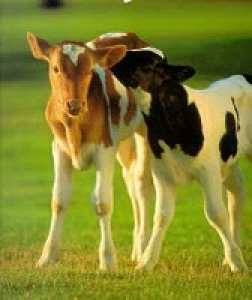Feeds for calves
Calves are what they eat

Your treatment of calves from the first hour of their life to the first six to eight weeks could impact their future milk producing ability. The data we’re generating at Cornell and evaluating from other research suggest dairies need to alter how they view their animals’ early stage of development, especially as it relates to future productivity.
Most dairy producers know the important relationship between calf health and growth and colostrum quality, yield and immunoglobulin (Ig) absorption. Studies have shown that low serum Ig status in calves relates to decreased growth rate and increased morbidity. Some studies even indicate that low serum Ig levels affect milk yield during first lactation.
A 1988 study indicated that calves with higher Ig status are able to inactivate pathogens prior to mounting a full immune response. This allows them to maintain energy and nutrient utilization for growth. But calves with low Ig status must first mount an immune response, diverting nutrients to defense mechanisms rather than growth.
How severe is this difference or for how long does it persist? Data from a 1989 study demonstrated that for each unit of serum IgG content above 12 mg/ml, there was an 18.7-pound increase in mature equivalent milk. This implies that calves with lower IgG content were more susceptible to immune challenges, which impacted long-term performance.
A 2005 study suggests the impact of serum Ig levels wasn’t nearly as great but still affected milk yield and survival through the second lactation. In that study, Brown Swiss calves received either 2 or 4 liters of colostrum just after birth.
Researchers monitored the animals for two lactations after calving at which time they made three observations:
1. There was a 30% increase in prepubertal growth rates based on colostrum feeding level under identical feeding conditions.
2. There was a 16% increase in survival to the end of the second lactation of calves fed the 4 liters of colostrum.
3. The surviving calves fed the 4 liters of colostrum produced 2,263 pounds more milk by the end of the second lactation. We don’t know if this response is due just to Igstatus or other factors in colostrum. But it suggests that colostrum quantity is important for long-term productivity in addition to what we have traditionally thought of as immune status.
Early eating, later production
Many studies have allowed researchers to look at milk yield from cattle that received more nutrients up to eight weeks of age. (Table 1) In each study, increased nutrient intake prior to 56 days resulted in 1,000 to 3,000 additional pounds of milk during the first lactation compared to calves under more restricted feeding during the same period.
In a recent Miner Institute study in Chazy, N.Y., researchers report that calves fed approximately 2 pounds per day of milk replacer produced 1,543 pounds more milk (at 200 days in milk) than calves receiving 1 pound of milk replacer powder per day. Calving age wasn’t affected by treatment. Averaging the studies shown in Table 1, there is a 1,700-pound response to increasing nutrient intake prior to weaning. Here’s the take-home point: The higher intake levels must be from liquid feed.
Table 1. Milk production differences among treatments where calves consume at least 50% more nutrients than standard feeding rate
Study Treatment difference, lb.
Foldager & Krohn, 1994 3,092
Bar-Peled et al., 1998 998
Foldager et al., 1997 1,143
Ballard et al., 2005 1,543 @ 200 DIM
Rincker et al.,2006 1,100 based on proj. 305 DIM
Moallem et al., 2006 2,500
Pollard et al., 2007 1,841
Cornell research We started feeding Cornell’s research herd for greater preweaning weight gains many years ago and have more than 1,000 weaning weights and 725 lactations with which to make evaluations. We analyzed the lactation data of the 725 heifers with completed lactations and evaluated several factors related to early life performance and their milk yield. Factors included birth weight, weaning weight, height at weaning, weight at 4 weeks of age and several others.
Our data are consistent with that shown in Table 1. Growth rate prior to weaning has the greatest correlation with first-lactation milk. In our data set, for every pound of average daily gain (ADG) prior to weaning, the heifers produced approximately 1,000 pounds more milk.
The range in preweaning growth rates among the 725 animals was 0.52 to 2.76 pounds per day. Also, 20% of the variation in first-lactation milk production could be explained by growth rate to weaning.
This has important ramifications:
- The impacts of Ig status and nutrient intake play a significant role in the performance and variation in first lactation milk yield.
- More milk will be achieved once we better understand the cause of the variation.
- To achieve these milk-yield responses from early life nutrition, calves must double their birth weight by weaning. This means milk or milk replacer intake must be greater than traditional programs for the first three to four weeks of life.
by Mike Van Amburgh, Emiliano Raffrenato and Bob Everett - Northeast Dairy Business Pro-dairy






















